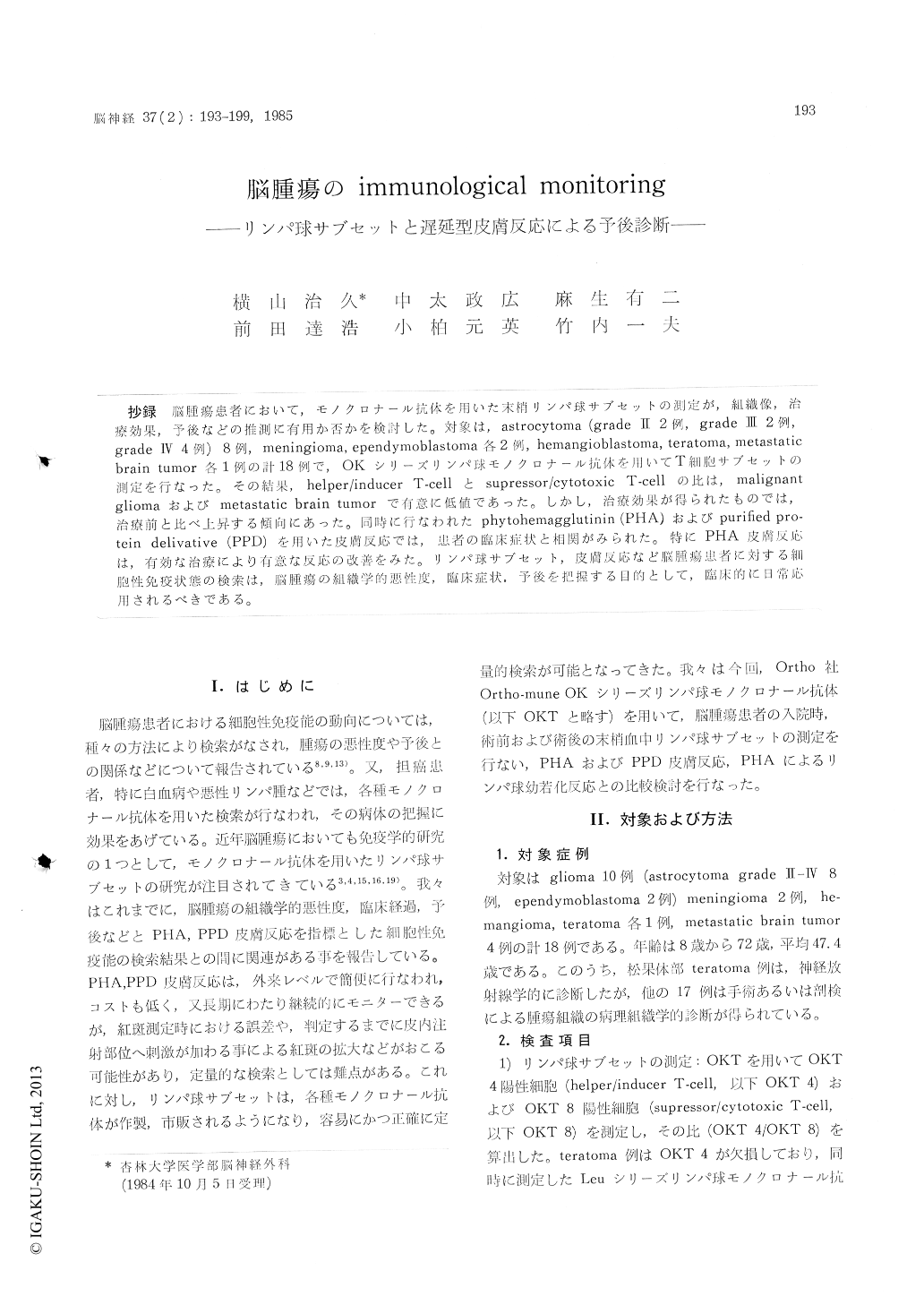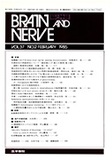Japanese
English
- 有料閲覧
- Abstract 文献概要
- 1ページ目 Look Inside
抄録 脳腫瘍患者において,モノクロナール抗体を用いた末梢リンパ球サブセットの測定が,組織像,治療効果,予後などの推測に有用か否かを検討した。対象は,astrocytoma (gradeⅡ 2例,grade Ⅲ2例,grade IV 4例)8例,meningiomna,ependymoblastoma各2例,hemangioblastoma,teratoma,metastaticbrain tumor各1例の計18例で,OKシリーズリンパ球モノクロナール抗体を用いてT細胞サブセットの測定を行なった。その結果,helper/inducer T-cellと supressor/cytotoxic T-cellの比は,malignantgliomaおよびmetastatic brain tumorで有意に低値であった。しかし,治療効果が得られたものでは,治療前と比べ上昇する傾向にあった。同時に行なわれたphytohemagglutinin (PHA)およびpurifed pro—tein delivative (PPD)を用いた皮膚反応では,患者の臨床症状と相関がみられた。特にPHA皮膚反応は,有効な治療により有意な反応の改善をみた。りンパ球サブセット,皮膚反応など脳腫賜}患折に対する細胞性免疫状態の検索は,脳腫瘍の紅織学的悪性度,臨床症状,予後を把握する目的として,臨床的に日常応用されるべきである。
We have already reported on the usefulness of the phytohemagglutinin (PHA) skin test and the purified protein derivative (PPD) skin test in pre-dicting the prognosis of brain tumor patients. This paper outlines our investigation of T-lymphocyte subpopulations and analysis of their utilization. The cellular immunological states of brain tumor patients were examined by means of PHA and PPD skin tests, the blastogenic response of T-lymphocytes to PHA and the T-lymphocyte subpo-pulations. Our subjects consisted of 10 cases of glioma (8 astrocytoma, 2 ependymoma), 2 cases of meningioma, one of teratoma, one of hemangio- blastoma and 4 of metastatic brain tumor. These were divided into 2 groups:the benign group, which included low grade astrocytoma, meningio- ma, teratoma and hemangioblstoma, and the malig-nant group which included malignant glioma and metastatic brain tumor. The T-lymphocytes were counted by monoclonal antibody assay using Ortho-mune T-lymphocyte monoclonal antibody (OK series). We then counted an analysis to de-termine metastatic brain tumor. The T-Iymphocy-tee were counted by monoclonal antibody assay using Ortho-mune T-lymphocyte monoclonal anti-body (OK series). We then conducted an analysis to determine whether or not the T-lymphocyte subpopulations could be of value in the prediction of the possible prognosis of patients. The results were as described below.
Ratios of helper/inducer T-lymphocytes (OKT 4 positive cells : Th) to suppressor/cytotoxic T-lymphocytes (OKT 8 positive cells : Ts) were 1.78 ±0.18 in the benign group and 1.00±0.49 in the malignant group. The mean diameters of PHA and PPD skin reactions were 25.0±7.5 mm and 16.0±9.0mm, respectively, in the benign group, and 17.5±12.5 mm and 5.5±7.0mm, respectively, in the malignant group. At the time of their admission, the ratios of Th to Ts were 1.31±0.66 for patients of good performance status (ECOG ; Eastern Cooperative Oncology Group grad-ings 0, 1, 2) and 1.20±0.45 for patients of poor performance status (ECOG gradings 3, 4). Fur-thermore, the mean diameters of PHA and PPD skin reactions were 24.4±10.9mm and 12.4±11.0 mm, respectively, in the former group, and 15.8± 12.4mm and 6.0±6.9 mm, respectively, in the latter group. There was no significant difference in the blastogenic response of T-lymphocytes toPHA between the benign group and the malignant group, or between the patients of good performan-ce status and poor performance status at the time of their admission.
Conclusion
1) At the time of admission, the ratio of Th to Ts was low in the malignant group (Th/Ts=1.00 ±0.49) and high in the benign group (Th/Ts= 1.78±0.18) (p<0.01)
2) The ratio of Th to Ts was high for patients showing improvement after treatment (Th/Ts= 2.94±2.93) and low for patients showing no im-provement (Th/Ts=0.92 10.44).
3) There was no correlation between the ratio of Th to Ts and the performance status at the time of admission.
The data obtained indicates that, in addition to PHA and PPD skin reactions, determination of the status of T-lymphocyte subpopulations is of value in the immnological monitoring of brain tumor patients. It also strongly suggests that such immunological monitoring should be carried out to both investigate the effect of treatment and predict the probable prognosis of brain tumor patients.

Copyright © 1985, Igaku-Shoin Ltd. All rights reserved.


